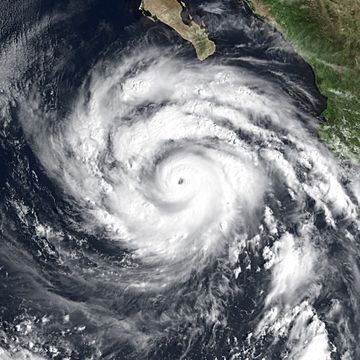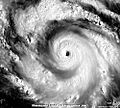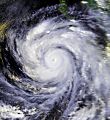Hurricane Linda (1997) facts for kids
| Category 5 major hurricane (SSHWS/NWS) | |

Hurricane Linda near peak intensity on September 12.
|
|
| Formed | September 9, 1997 |
|---|---|
| Dissipated | September 17, 1997 |
| Highest winds | 1-minute sustained: 185 mph (295 km/h) |
| Lowest pressure | 902 mbar (hPa); 26.64 inHg (East Pacific record) |
| Fatalities | 8 indirect |
| Damage | $70.3 million (1997 USD) |
| Areas affected | Open Pacific Ocean waters, Socorro Island, California |
| Part of the 1997 Pacific hurricane season | |
Hurricane Linda was a very powerful storm that happened in 1997. It was one of the strongest hurricanes ever recorded in the eastern Pacific Ocean. It had winds of about 185 miles per hour (160 knots).
Linda was part of a very busy hurricane season in 1997. Even though it was super strong, it mostly stayed far from land. This meant it didn't cause a lot of damage in most places.
Contents
How Hurricane Linda Formed and Traveled
Hurricane Linda started as a "tropical wave" that moved off the coast of Africa on August 24, 1997. A tropical wave is like a ripple in the air that can sometimes grow into a storm. This wave crossed the Atlantic Ocean without getting stronger.
When it reached Central America, the weather conditions changed. The storm began to get more organized. On September 9, it officially became a "tropical depression." This is the first stage of a tropical storm. It was about 400 nautical miles south of Manzanillo, Mexico.
Linda Becomes a Hurricane
The tropical depression kept moving northwest. On September 10, it grew stronger and became a "tropical storm." Tropical storms have stronger winds than tropical depressions. Linda then started to get much more powerful, very quickly.
By September 11, Linda had become a full-blown hurricane. It was about 475 nautical miles south-southeast of the southern tip of Baja California.
Peak Strength and Weakening
Linda kept getting stronger for about 30 hours. On September 12, it reached its top strength with winds of 185 miles per hour (160 knots). This was a huge increase in power in a short time.
On the same day, Linda passed directly over Socorro Island as a very strong Category 5 hurricane. After passing the island, the hurricane moved into cooler waters. Cooler waters make hurricanes lose their strength. Linda weakened a lot and finally disappeared on September 17.
Impact of Hurricane Linda
Even though Hurricane Linda was very powerful, it mostly stayed over the open ocean. This limited the damage it caused.
Damage in Mexico
Linda passed over Socorro Island in Mexico. It caused about $3.2 million in damage there. This island is not heavily populated, so the damage was not widespread.
Impact in California
Hurricane Linda also affected California, even though it didn't directly hit the state. The storm caused some big waves and heavy rains. Sadly, eight people died because of the storm's effects in California.
The strong waves caused problems near a jetty, and some people lost their lives there. Heavy rains led to floods and mudslides. Mudslides are when a lot of wet earth and rocks slide down a hill. These mudslides destroyed homes and caused about $68 million in damage.
Weeks later, another hurricane called Hurricane Nora also caused damage in the Southwest United States.
Related pages
Images for kids
See also
 In Spanish: Huracán Linda (1997) para niños
In Spanish: Huracán Linda (1997) para niños




